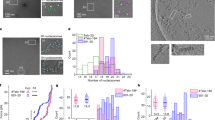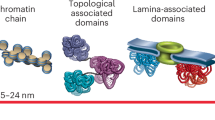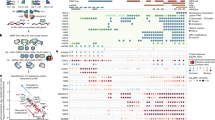Abstract
THE DNA in the nucleosome is tightly wound in about two turns around a core protein octamer (reviewed in refs 1 and 2), and in this conformation the two strands of the double helix cannot be separated. Chromatin known to be transcriptionally active exhibits differences, both in the packing ratio of the DNA and in appearance under the electron microscope. At the same time, the periodicity revealed by nuclease digestion of nucleosomes is preserved, and histones remain attached to the DNA2,3. This evidence strongly suggests that chromatin has the ability to undergo a conformational transition between a folded and an open state. Previous electron microscopic observations4,5 have revealed that at very low ionic strengths nucleosomes undergo two transitions, one apparently involving a dissociation into ‘half-nucleosomes’, the other a transformation to a fully extended state. Transitions have also been deduced from hydro-dynamic studies6 and analysis of thermal denaturation profiles7,8. All these methods are applied to dilute solutions and are confined to conditions in which the chromatin is soluble. On the other hand, methods usable at high concentrations have failed to produce evidence of an unfolded state at neutral pH, even when the concentrated chromatin solution was first dialysed against solutions of very low ionic strength. This seeming inconsistency can be understood, however, if one considers the concentration of the excess negative charges on the phosphate groups of the DNA in the condensed state, for as a consequence of the Donnan effect, one cannot reduce the sodium ion concentration below the level of charge equivalence without also lowering the pH. We now report the characterisation of a pH-dependent reversible transition of chromatin to an unfolded form.
This is a preview of subscription content, access via your institution
Access options
Subscribe to this journal
Receive 51 print issues and online access
$199.00 per year
only $3.90 per issue
Buy this article
- Purchase on SpringerLink
- Instant access to full article PDF
Prices may be subject to local taxes which are calculated during checkout
Similar content being viewed by others
References
Kornberg, R. D. A. Rev. Biochem. 46, 931–954 (1977).
Felsenfeld, G. Nature 271, 115–122 (1978).
Lilley, D. M. J. Cell Biol. Int. Rep. 2, 1–10 (1978).
Tsanev, R. & Petrov, P. J. microsc. Biol. Cell 27, 11–18 (1976).
Oudet, P., Spadafora, C. & Chambon, P. Cold Spring Harb. Symp. quant. Biol. 42, 301–312 (1977).
Gordon, V. C., Knobler, C. M., Olins, D. E. & Schumaker, V. N. Proc. natn. Acad. Sci. U.S.A. 75, 660–663 (1978).
Chipev, C. & Staynov, D. Z. Biopolymers 17, 957–968 (1978).
Venkov, C., Chipev, C., Katarova, Z. & Staynov, D. Z. (in preparation).
Spencer, M. & Staynov, D. Z. (in preparation).
Bradbury, E. M. et al. in The Molecular Biology of the Mammalian Genetic Apparatus (ed. Ts'o, P. O. P.) 53–70 (North-Holland, Amsterdam, 1977).
Richards, B. M. et al. in Current Chromosome Research (eds Jones, K. & Brandham, P. E.) 7–16 (North-Holland, Amsterdam, 1976).
Carlson, R. D. & Olins, D. E. Nucleic Acids Res. 3, 89–100 (1976).
Subirana, J. A. & Martínez, A. B. Nucleic Acids Res. 3, 3025–3042 (1976).
Finch, J. T. et al. Nature 269, 29–36 (1977).
Finch, J. T. & Klug, A. Cold Spring Harb. Symp. quant. Biol. 42, 1–9 (1977).
Pardon, J. F. et al. Nucleic Acids Res. 4, 3199–3214 (1977).
Suau, P., Kneale, G. G., Braddock, G. W., Baldwin, J. P. & Bradbury, E. M. Nucleic Acids Res. 4, 3769–3786 (1977).
Subirana, J. A. et al. in The Molecular Biology of the Mammalian Genetic Apparatus (ed. Ts'o, P. O. P.) 71–92 (North-Holland, Amsterdam, 1977).
Luzzati, V. & Nicolaieff, A. J. molec. Biol. 1, 127–133 (1959).
Luzzati, V. & Nicolaieff, A. J. molec. Biol. 7, 142–163 (1963).
Bradbury, E. M., Molgaard, H. V., Stephens, R. M., Bolund, L. A. & Johns, E. W. Eur. J. Biochem. 31, 474–482 (1972).
Bradbury, E. M. et al. Brookhaven Symp. Biol. 27, (IV) 97–117 (1975).
Pardon, J. F., Wilkins, M. H. F. & Richards, B. M. Nature 215, 508–509 (1967).
Pardon, J. F., Richards, B. M. & Cotter, R. I. Cold Spring Harb. Symp. quant. Biol. 38, 75–81 (1973).
Zama, M., Olins, D. E., Prescott, B. & Thomas, G. J. Nucleic Acids Res. 5, 3881–3897 (1978).
Gould, H. J., Maryanka, D., Fey, S. J., Cowling, G. J. & Allan, J. Meth. Cell Biol. 19, 387–422 (1978).
Author information
Authors and Affiliations
Rights and permissions
About this article
Cite this article
STAYNOV, D., SPENCER, M., ALLAN, J. et al. A reversible conformational transition in chromatin. Nature 279, 263–265 (1979). https://doi.org/10.1038/279263a0
Received:
Accepted:
Issue date:
DOI: https://doi.org/10.1038/279263a0
This article is cited by
-
Salt-induced structural changes in nucleosomes
Molecular Biology Reports (1980)



